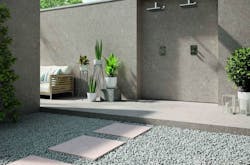Fresh Tile Styles that Impact Interiors and Design Budgets
Throughout history, tile has thrived as a decorative material for both indoor and outdoor spaces. Today, the hard surface has designers rethinking the possibilities when it comes to modern applications due to new technologies emerging in the global surfacing industry.
Many of the 125 manufacturers that comprise the Tile of Spain association are transforming the notable material into new shapes and forms with advanced technologies and machinery.
These fresh styles of tile—including varying thicknesses, 3D textures, large-slab formats, and digitally augmented and optimized production processes—are gaining attention by designers looking to create unlimited interior applications and clients seeking a budget-friendly option.
Gauged Porcelain Tile: Big in Size and Impact
Among the fastest-growing product sectors in demand for the tile industry is gauged porcelain tiles, also known as large-formatted slabs or panels. These large tiles are sought after for their high-end aesthetic and ability to carry a continuous pattern throughout the slab.
(Photo: Ceilook is a lightweight tile that can be used in acoustical ceiling applications. Credit: Tile of Spain)
Gauged porcelain tiles are also becoming widely accepted due to their availability, as the moniker suggests, in varying thicknesses. Thin tiles, in particular, are gaining in popularity—especially in specific interior markets like commercial cruise liners, yachts and luxury RVs, as the slimmer profile means less weight for a premium and durable surface.
Even ceilings are taking advantage of the lighter slabs. Tile of Spain manufacturers Azuliber and Bestile collaborated with research company Neos Cerámica to create Ceilook, an innovative product that allows ceramic tile to be used in acoustical ceiling applications.
Suspended from an integrated track system and backed with an insulation mat, these tiles can offer thermal and sound-deadening properties along with fire-retardance while still working as a design feature within the space.
The current average industry size standards for ultra-thin gauged porcelain consists of 3-, 6- and 12-millimeter applications.
Extra-thick tiles, such as 20- and 30-millimeter-thick slabs, are also expanding in use. Tile of Spain manufacturer Rocersa applies digital graphics through dry digital systems (DDS) that can create images through the entire body of thick tile.
This gives surfaces a finished, smooth aesthetic from edge to edge. Designers and clients can specify almost any finish, texture or look within the tile, from subtle to sublime.
Having multiple thicknesses available in the same look can be helpful when transitioning from floor to wall, but especially when moving from interiors to matching exteriors.
Some tile producers have even found ways to laminate induction range tops within gauged porcelain slabs to create a seamless induction range oven within a large-slabbed tile surface.
Because of its fire-resistant properties and low conductivity, gauged porcelain slabs for worktops are ideal for commercial kitchens, restaurants and small-footprint residential spaces where multi-purpose elements are essential.
Tile vs. Other Hard Surfaces
As tile trends continue to evolve, the material’s cost still remains budget-friendly for any size project. For one, it reduces both fiscal and environmental burden specifically because it lasts longer than competing surfaces.
Based on Product Category Rules (PCR) for flooring category Environmental Product Declarations (EPD), all products must report their environmental impact for virgin use as well as the amortized data over the agreed average 50-year lifespan of a building.
Tile is one of the few materials with nearly identical statistics in both of these reports. Its long lifespan with low maintenance requirements flourishes in high-traffic environments due to its durability, strength and resistance to scratches.
It also makes for an ideal hard surface in commercial spaces where cleanliness is a must. Tile offers hygiene and safety benefits, including:
- Inhospitable to bacteria, meaning no mold or mildew—emerging value-add technology using catalytic oxides actually break down organics in contact with the surface using light as an energy source
- Stain resistant, when glazed
- Water resistant
- Cleans easily with water or steam
- Fire resistant—will not burn or smoke at any temperature
The material provides a low-maintenance solution, regardless of its application. Even the modern tile trends like ultra-thin gauged porcelain slabs are finding ways to save money—a one-millimeter difference in thickness can have major impact on a project’s overall budget.
As its thinner frame weighs less, this style costs less to ship across seas. Plus, skinny tile is easy to cut, lighter to handle, and in some cases can be directly laid over existing tiles during renovations, which further saves both time and money.
Tile Takeaways
The tile industry is one of the few manufacturing sectors that continues to keep pace with the technology sector regarding development and innovation. Selecting the perfect product for the job is no easy task considering the many tile options available on the market today.
Knowing the properties of each style of tile before specifying product and specification best-practices described by industry handbooks and international standards will help minimize costly remedial procedures for surface prep, thereby lowering installation costs to further expand a project’s product budget.
To learn more about the tile industry, standards and how the material can be used as a sustainable surfacing solution for your next commercial interior project, visit tileofspainusa.com.
